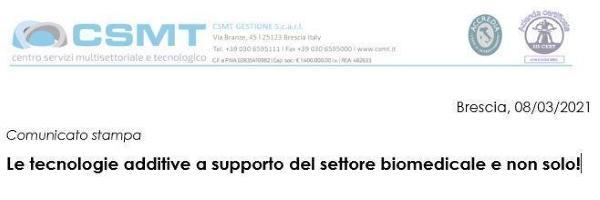Additive manufacturing event
Brescia, 08/03/2021
Press release
Additive technologies to support the biomedical sector and beyond!
Riccardo Trichilo, President and CEO of CSMT Polo Tecnologico, opened the seminar dedicated to Additive Manufacturing by introducing the guests and experts in additive technologies who followed one another during the meeting, which culminated in a high-level round table discussion between the public and private sectors.
The ice was broken by the world of research, the University of Brescia, with Dr. Paola Ginestra studying the progress of additive technologies in the biomedical field. We started by defining the concept of Additive Manufacturing: the term encompasses processes aimed at producing models and components precisely by adding material (layer by layer), starting from a three-dimensional mathematical model. Unlike traditional machines that operate by successive subtraction of material, AM systems produce successive layers of liquid, powder, wire or laminate. Layer by layer, these machines reconstruct the initial mathematical model (Layer Manufacturing). This is certainly not a simple production process, but one with enormous potential for evolution and refinement.
Following this, Professors Elisabetta Ceretti and Keren Zohar-Hauber introduced the Joint Innovation Program between Italy and Israel, which has taken concrete form in Optimib, a research and industrial development project involving the University of Brescia and the corresponding Israeli research institute Technion, as well as the CSMT technology centre and the private company KANFIT3D. The shared objective of the project, which has recently come to an end, was to identify the optimal process parameters for the production of titanium alloy implants capable of adapting perfectly to the geometry of patients and with properties that prevent bacterial rejection.
The meeting then got into full swing: moderating the round table of AM experts was Paolo Folgarait, CEO of Seamthesis. Among research, innovation and development projects of additive technologies, the focus was broadened beyond the biomedical sector.
Researcher Bianca Colosimo, representing and a member of the technical committee of the MADE Competence Center, described the mission of the digital and sustainable factory that acts as a reference point for orientation, training and innovative projects based on new technologies: on the one hand with the virtual design and simulation area and on the other with that linked to production, including enabling additive technology. MADE provides skills related to additive redesign, redesign, functional prototyping, a printing system, finishing and quality control. A set of integrated tools to be able to accompany companies in the additive manufacturing process in order to help them reduce time to market.
The floor was passed to Cristian Fracassi, CEO of ISINNOVA, a company that distinguished itself during the Covid period for its "famous" breathing mask: created from a snorkelling mask, which was modified thanks to the introduction of a specific Charlotte valve attached to the top of the object in place of the mouthpiece. The 3D file of the mask, made available for free, was the most downloaded 3D file in the history of 3D printing.
Gabriele Ceselin, CEO of AQM, focused on the theme of non-destructive testing linked to additive manufacturing, i.e. checking the integrity of the object without damaging it and compromising its final use. In fact, unlike mechanical machining, 3D processing does not allow such a smooth and precise product to be obtained.
From the macro to the micro: the time has come for Stefano Linari, founder and director of Linari Nanotech, a company specialising in printing nano materials and nano fibres. Their production involves a process that is halfway between classic extrusion and electrostatic coating. Their equipment produces a continuous nanometric filament under the effect of an electric field which allows it to be moulded into a non-woven fabric with a macroscopic thickness, thus enabling the creation mainly of components for tissue engineering.
The seminar was concluded by two important companies active in the promotion of technological and digital innovations: innexhub and AFIL. Marco Libretti, director of innexhub explained how the non-profit association is moving in the Additive Manufacturing field and can support the development of the territory with reference to the biomedical sector, confirming itself as a connecting element between companies and the world of research. Giacomo Copani, representative of the AFIL regional cluster, described how the cluster can support research and innovation in the Lombardy supply chain by creating an interconnected facilitating environment: on the one hand with regional institutions and on the other with European and national initiatives, including global ones. In the specific case of AM, a dedicated community has been active for some time and has generated initiatives of great value for Lombardy's manufacturing sector.
Alberto Bonetti, CSMT Project Funding Manager, will lead the afternoon. For more information on the area of funded projects and how to apply the technologies discussed at the meeting within the framework of innovation initiatives financed by regional, national and European funds, please contact him at the following numbers: E. a.bonetti@csmt.it - T. 342 8710060

